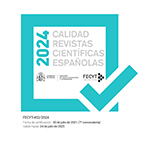Iconografía de Polifemo: la tradición homérica y sus pervivencias
Abstract
Desde el siglo VII a.C., las representaciones artísticas recrearon con frecuencia el encuentro de Odiseo y el cíclope Polifemo, así como el escarnio de que fue objeto el sanguinario monstruo. Dichas representaciones se han distinguido por su carácter eminentemente narrativo, expresión de dos estadios contradictorios: civilización y barbarie. Tanto Grecia como Etruria asociaron frecuentemente el tema a los contextos funerarios y al triunfo sobre la muerte, mientras que el mundo romano acrecentó el carácter teatral y la utilización propagandística del mismo, cuyo signifi cado se fue transformando, hasta subvertirse en la Edad Moderna y Contemporánea, paralelo al devenir histórico.Downloads
##submission.format##
Licenza
La revista Cuadernos de Filología Clásica. Estudios griegos e indoeuropeos, para fomentar el intercambio global del conocimiento, facilita el acceso sin restricciones a sus contenidos desde el momento de su publicación en la presente edición electrónica, y por eso es una revista de acceso abierto. Los originales publicados en esta revista son propiedad de la Universidad Complutense de Madrid y es obligatorio citar su procedencia en cualquier reproducción total o parcial. Todos los contenidos se distribuyen bajo una licencia de uso y distribución Creative Commons Reconocimiento 4.0 (CC BY 4.0). Esta circunstancia ha de hacerse constar expresamente de esta forma cuando sea necesario. Puede consultar la versión informativa y el texto legal de la licencia.










